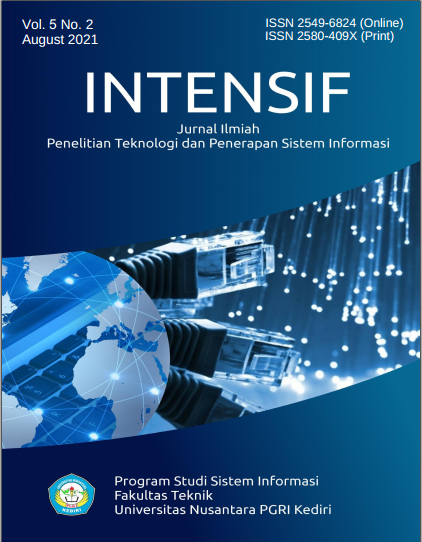Semi-Adaptive Control Systems on Self-Balancing Robot using Artificial Neural Networks
DOI:
https://doi.org/10.29407/intensif.v5i2.15296Keywords:
semi-adaptive control system, self-balancing robot, artificial neural networkAbstract
A self-balancing type of robot works on the principle of maintaining the balance of the load's position to remains in the center. As a consequence of this principle, the driver can go forward reverse the vehicle by leaning in a particular direction. One of the factors affecting the control model is the weight of the driver. A control system that has been designed will not be able to balance the system if the driver using the vehicle exceeds or less than the predetermined weight value. The main objective of the study is to develop a semi-adaptive control system by implementing an Artificial Neural Network (ANN) algorithm that can estimate the driver's weight and use this information to reset the gain used in the control system. The experimental results show that the Artificial Neural Network can be used to estimate the weight of the driver's body by using 50-ms-duration of tilt sensor data to categorize into three defined classes that have been set. The ANN algorithm provides a high accuracy given by the results of the confusion matrix and the precision calculations, which show 99%.
Downloads
References
J. Y. Yong, V. K. Ramachandaramurthy, K. M. Tan, and N. Mithulananthan, "A review on the state-of-the-art technologies of electric vehicle, its impacts, and prospects," Renewable and Sustainable Energy Reviews. 2015, DOI: 10.1016/j.rser.2015.04.130.
G. W. Shin, K. J. Lee, D. Park, J. H. Lee, and M. H. Yuri, "Personal mobility device and user experience: A state-of-the-art literature review," 2018, DOI: 10.1177/1541931218621305.
A. Pourmand, J. Liao, J. M. Pines, and M. Mazer-Amirshahi, "Segway® Personal Transporter-Related Injuries: A Systematic Literature Review and Implications for Acute and Emergency Care," J. Emerg. Med., vol. 54, no. 5, 2018, DOI: 10.1016/j.jemermed.2017.12.019.
K. Boniface, M. P. McKay, R. Lucas, A. Shaffer, and N. Sikka, "Serious injuries related to the Segway® personal transporter: A case series," Ann. Emerg. Med., 2011, doi: 10.1016/j.annemergmed.2010.06.551.
S. C. & V. V. Shubhank Sondhia, Ranjith Pillai. R, Sharat S. Hegde, "Development of Self Balancing Robot With PID Control," Int. J. Robot. Res. Dev. (IJRRD, 2017.
R. S. Martins and F. Nunes, "Control system for a self-balancing robot," 2017, DOI: 10.1109/EXPAT.2017.7984388.
S. Trimpe, A. Millane, S. Doessegger, and R. D'Andrea, "A self-tuning LQR approach demonstrated on an inverted pendulum," 2014, DOI: 10.3182/20140824-6-za-1003.01455.
Y. Gong, X. Wu, and H. Ma, "Research on Control Strategy of Two-Wheeled Self-Balancing Robot," 2016, DOI: 10.1109/CSMA.2015.63.
R. Babazadeh, A. G. Khiabani, and H. Azmi, “Optimal control of Segway personal transporter,” 2016, doi: 10.1109/ICCIAutom.2016.7483129.
J. Huang, M. Ri, D. Wu, and S. Ri, "Interval type-2 fuzzy logic modeling and control of a mobile two-wheeled inverted pendulum," IEEE Trans. Fuzzy Syst., 2018, DOI: 10.1109/TFUZZ.2017.2760283.
C. H. Huang, W. J. Wang, and C. H. Chiu, "Design and implementation of fuzzy control on a two-wheel inverted pendulum," IEEE Trans. Ind. Electron., 2011, DOI: 10.1109/TIE.2010.2069076.
A. S. Wardoyo, S. Hendi, D. Sebayang, I. Hidayat, and A. Adriansyah, "An investigation on the application of fuzzy and PID algorithm in the two-wheeled robot with the self-balancing system using microcontroller," 2015, DOI: 10.1109/ICCAR.2015.7166003.
L. Chen et al., "Robust hierarchical sliding mode control of a two-wheeled self-balancing vehicle using perturbation estimation," Mech. Syst. Signal Process., 2020, DOI: 10.1016/j.ymssp.2019.106584.
A. Castro, C. Adams, and W. Singhose, "Dynamic response characteristics of a two-wheeled inverted-pendulum transporter," 2013, DOI: 10.1109/CDC.2013.6760100.
G. Bobby, E. Susanto, and F. Y. Suratman, “Implementasi Robot Keseimbangan Beroda Dua Berbasis Mikrokontroler,” ELKOMIKA J. Tek. Energi Elektr. Tek. Telekomun. Tek. Elektron., vol. 3, no. 2, p. 142, 2015, doi: 10.26760/elkomika.v3i2.142.
P. Frankovský, L. Dominik, A. Gmiterko, I. Virgala, P. Kurylo, and O. Perminova, "Modeling of two-wheeled self-balancing robot driven by DC gearmotors," Int. J. Appl. Mech. Eng., 2017, DOI: 10.1515/ijame-2017-0046.
S. Kwon, S. Kim, and J. Yu, "Tilting-type balancing mobile robot platform for enhancing lateral stability," IEEE/ASME Trans. Mechatronics, 2015, DOI: 10.1109/TMECH.2014.2364204.
F. Dai, J. Li, J. Peng, Z. Zhu, S. Jiang, and X. Gao, "Design and Control of a Multi-DOF Two-Wheeled Inverted Pendulum Robot," 2014, DOI: 10.1109/WCICA.2014.7052763.
G. Varoquaux, L. Buitinck, G. Louppe, O. Grisel, F. Pedregosa, and A. Mueller, “Scikit-learn,” GetMobile Mob. Comput. Commun., 2015, DOI: 10.1145/2786984.2786995.
F. P'erez and B. E. Granger, "Jupyter Notebook Documentation," Comput. Sci. Eng., 2018.
Downloads
Published
Issue
Section
License
Authors who publish with this journal agree to the following terms:
- Copyright on any article is retained by the author(s).
- The author grants the journal, the right of first publication with the work simultaneously licensed under a Creative Commons Attribution License that allows others to share the work with an acknowledgment of the work’s authorship and initial publication in this journal.
- Authors are able to enter into separate, additional contractual arrangements for the non-exclusive distribution of the journal’s published version of the work (e.g., post it to an institutional repository or publish it in a book), with an acknowledgment of its initial publication in this journal.
- Authors are permitted and encouraged to post their work online (e.g., in institutional repositories or on their website) prior to and during the submission process, as it can lead to productive exchanges, as well as earlier and greater citation of published work.
- The article and any associated published material is distributed under the Creative Commons Attribution-ShareAlike 4.0 International License












